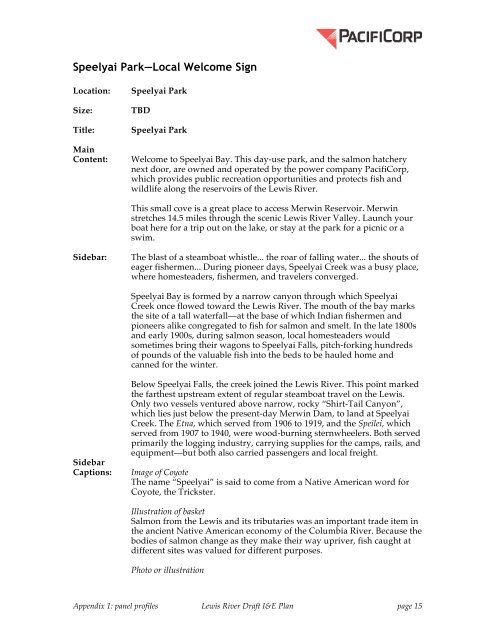The Lewis River Hydroelectric Projects - PacifiCorp
The Lewis River Hydroelectric Projects - PacifiCorp
The Lewis River Hydroelectric Projects - PacifiCorp
Create successful ePaper yourself
Turn your PDF publications into a flip-book with our unique Google optimized e-Paper software.
Speelyai Park—Local Welcome Sign<br />
Location:<br />
Size:<br />
Title:<br />
Main<br />
Content:<br />
Speelyai Park<br />
TBD<br />
Speelyai Park<br />
Welcome to Speelyai Bay. This day-use park, and the salmon hatchery<br />
next door, are owned and operated by the power company <strong>PacifiCorp</strong>,<br />
which provides public recreation opportunities and protects fish and<br />
wildlife along the reservoirs of the <strong>Lewis</strong> <strong>River</strong>.<br />
This small cove is a great place to access Merwin Reservoir. Merwin<br />
stretches 14.5 miles through the scenic <strong>Lewis</strong> <strong>River</strong> Valley. Launch your<br />
boat here for a trip out on the lake, or stay at the park for a picnic or a<br />
swim.<br />
Sidebar:<br />
<strong>The</strong> blast of a steamboat whistle... the roar of falling water... the shouts of<br />
eager fishermen... During pioneer days, Speelyai Creek was a busy place,<br />
where homesteaders, fishermen, and travelers converged.<br />
Speelyai Bay is formed by a narrow canyon through which Speelyai<br />
Creek once flowed toward the <strong>Lewis</strong> <strong>River</strong>. <strong>The</strong> mouth of the bay marks<br />
the site of a tall waterfall—at the base of which Indian fishermen and<br />
pioneers alike congregated to fish for salmon and smelt. In the late 1800s<br />
and early 1900s, during salmon season, local homesteaders would<br />
sometimes bring their wagons to Speelyai Falls, pitch-forking hundreds<br />
of pounds of the valuable fish into the beds to be hauled home and<br />
canned for the winter.<br />
Sidebar<br />
Captions:<br />
Below Speelyai Falls, the creek joined the <strong>Lewis</strong> <strong>River</strong>. This point marked<br />
the farthest upstream extent of regular steamboat travel on the <strong>Lewis</strong>.<br />
Only two vessels ventured above narrow, rocky “Shirt-Tail Canyon”,<br />
which lies just below the present-day Merwin Dam, to land at Speelyai<br />
Creek. <strong>The</strong> Etna, which served from 1906 to 1919, and the Speilei, which<br />
served from 1907 to 1940, were wood-burning sternwheelers. Both served<br />
primarily the logging industry, carrying supplies for the camps, rails, and<br />
equipment—but both also carried passengers and local freight.<br />
Image of Coyote<br />
<strong>The</strong> name “Speelyai” is said to come from a Native American word for<br />
Coyote, the Trickster.<br />
Illustration of basket<br />
Salmon from the <strong>Lewis</strong> and its tributaries was an important trade item in<br />
the ancient Native American economy of the Columbia <strong>River</strong>. Because the<br />
bodies of salmon change as they make their way upriver, fish caught at<br />
different sites was valued for different purposes.<br />
Photo or illustration<br />
Appendix 1: panel profiles <strong>Lewis</strong> <strong>River</strong> Draft I&E Plan page 15
















